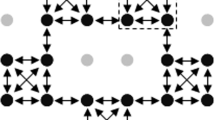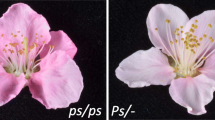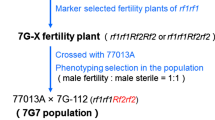Abstract
Key message
A self-fertility locus was fine mapped to a 1.6 cM region on linkage group 5 in a perennial ryegrass population. This locus was the main determinant of pollen self-compatibility.
Abstract
In grasses, self-incompatibility (SI) is characterized by a two-loci gametophytic (S and Z) mechanism acting together in the recognition and inhibition of self-pollen. Mutations affecting the expression of SI have been reported in a few grass species. In perennial ryegrass (Lolium perenne L.), a mutation independent from S and Z, and map** on linkage group 5 (LG 5), was previously reported to produce self-fertile plants. Here, we describe fine map** of the self-fertility (SF) gene in a perennial ryegrass population and determine whether there is any effect of other genomic regions on the pollen compatibility. The phenotypic segregation of SF showed a bimodal distribution with one mean at 49% pollen compatibility and the other at 91%. Marker-trait association analysis showed that only markers on LG 5 were significantly associated with the trait. A single gene model explained 82% of the observed variability and no effects of the other regions were detected. Using segregation and linkage analysis, the SF locus was located to a 1.6 cM region on LG 5. The flanking marker sequences were aligned to rice and Brachypodium distachyon reference genomes to estimate the physical distance. We provide markers tightly linked to SF that can be used for introgression of this trait into advanced breeding germplasm. Moreover, our results represent a further step towards the identification of the SF gene in LG 5.




Similar content being viewed by others
References
Arias-Aguirre A, Studer B, Do Canto J, Frei U, Lübberstedt T (2013) Map** a new source of self-fertility in perennial ryegrass (Lolium perenne L.). Plant Breed Biotechnol 1(4):385–395
Baumann U, Juttner J, Bian X, Langridge P (2000) Self-incompatibility in the grasses. Ann Bot 85:203–209
Buetow KH, Chakravarti A (1987) Multipoint gene map** using seriation. I. General methods. Am J Hum Genet 41:180–188
Connor HE (1979) Breeding systems in the grasses: a survey. N Z J Bot 17(4):547–574
Do Canto J, Studer B, Lübberstedt T (2016) Overcoming self-incompatibility in grasses: a pathway to hybrid breeding. Theor Appl Genet 129(10):1815–1829
Doerge RW (1996) Constructing genetic maps by rapid chain delineation. J Agric Genom 2(6):1–15
Doyle JJ, Doyle JL (1987) A rapid DNA isolation procedure for small quantities of fresh leaf tissue. Phytochem Bull 19:11–15
Egorova IA, Peneva TI, Baranova OA, Voylokov AV (2000) Analysis of linkage between biochemical and morphological markers of rye chromosomes 1R, 2R, and 5R and mutations of self-fertility at the main incompatibility loci. Russ J Genet 36(12):1423–1430
Elshire RJ, Glaubitz JC, Sun Q, Poland JA, Kawamoto K, Buckler ES, Mitchell SE (2011) A robust, simple genoty**-by-sequencing (GBS) approach for high diversity species. PLoS One 6(5):e19379. https://doi.org/10.1371/journal.pone.0019379
Freestone P, Nyström T, Trinei M, Norris V (1997) The universal stress protein, UspA, of Escherichia coli is phosphorylated in response to stasis. J Mol Biol 274(3):318–324
Frisch M, Bohn M, Melchinger AE (1999a) Minimum sample size and optimal positioning of flanking markers in marker-assisted backcrossing for transfer of a target gene. Crop Sci 39:967–975
Frisch M, Bohn M, Melchinger AE (1999b) Comparison of selection strategies for marker-assisted backcrossing of a gene. Crop Sci 39:1295–1301
Gupta P, Naithani S, Tello-Ruiz MK, Chougule K, D’Eustachio P, Fabregat A, Jiao Y, Keays M, Lee YK, Kumari S, Mulvaney J, Olson A, Preece J, Stein J, Wei S, Weiser J, Huerta L, Petryszak R, Kersey P, Stein LD, Ware D, Jaiswal P (2016) Gramene database: navigating plant comparative genomics resources. Curr Plant Biol 7:10–15
Hayman DL, Richter J (1992) Mutations affecting self-incompatibility in Phalaris coerulescens Desf. (Poaceae). Heredity 68:495–503
Hurst HC (1994) Transcription factors. 1: bZIP proteins. Protein Profile 1(2):123–168
Jensen LB, Andersen JR, Frei U, ** of vernalization response in perennial ryegrass (Lolium perenne L.) reveals co-location with an orthologue of wheat VRN1. Theor Appl Genet 110:527–536
Kho YO, Baer J (1968) Observing pollen tubes by means of fluorescence. Euphytica 17:298–302
Kosambi DD (1943) The estimation of map distances from recombination values. Ann Hum Genet 12(1):172–175
Li X, Paech N, Nield J, Hayman D, Langridge P (1997) Self-incompatibility in the grasses: evolutionary relationship of the S gene from Phalaris coerulescens to homologous sequences in other grasses. Plant Mol Biol 34:223–232
Lundqvist A (1954) Studies on self-sterility in rye Secale cereale L. Hereditas 40(3–4):278–294
Lundqvist A (1958) Self-incompatibility in rye IV. Factors related to self-seeding. Hereditas 44:193–256
Lundqvist A (1961) A rapid method for the analysis of incompatibility in grasses. Hereditas 47(3–4):705–707
Manzanares C (2013) Genetics of self-incompatibility in perennial ryegrass (Lolium perenne L.). Ph.D. thesis, The University of Birmingham, UK
Manzanares C, Barth S, Thorogood D, Byrne SL, Yates S, Czaban A, Asp T, Yang B, Studer B (2016) A gene encoding a DUF247 domain protein co-segregates with the S self-incompatibility locus in perennial ryegrass. Mol Biol Evol 33(4):870–884
Margarido GRA, Souza AP, Garcia AAF (2007) OneMap: software for genetic map** in outcrossing species. Hereditas 144:78–79
Martins WS, Soares Lucas DC, de Souza Neves KF, Bertioli DJ (2009) WebSat—a web software for microsatellite marker development. Bioinformation 3(6):282–283
Pfeifer M, Martis M, Asp T, Mayer KFX, Lübberstedt T, Byrne S, Frei U, Studer B (2013) The perennial ryegrass GenomeZipper: targeted use of genome resources for comparative grass genomics. Plant Physiol 161(2):571–582
Poland JA, Rife TW (2012) Genoty**-by-sequencing for plant breeding and genetics. Plant Genome 5:92–102
Ribaut JM, Hoisington D (1998) Marker-assisted selection: new tools and strategies. Trends Plant Sci 3(6):236–239
Rothberg JM, Jacobs JR, Goodman CS, Artavanis-Tsakonas S (1990) slit: an extracellular protein necessary for development of midline glia and commissural axon pathways contains both EGF and LRR domains. Genes Dev 4:2169–2187
Ruiz-Medrano R, Jimenez-Moraila B, Herrera-Estrella L, Rivera-Bustamante RF (1992) Nucleotide sequence of an osmotin-like cDNA induced in tomato during viroid infection. Plant Mol Biol 20(6):1199–1202
Studer B, Jensen LB, Fiil A, Asp T (2009) ‘‘Blind’’ map** of genic DNA sequence polymorphisms in Lolium perenne L. by high resolution melting curve analysis. Mol Breed 24:191–199
Studer B, Kölliker R, Muylle H, Asp T, Frei U, Roldán-Ruiz I, Barre P, Tomaszewski C, Meally H, Barth S, Skøt L, Armstead IP, Dolstra O, Lübberstedt T (2010) EST-derived SSR markers used as anchor loci for the construction of a consensus linkage map in ryegrass (Lolium spp.). BMC Plant Biol 10:177
Studer B, Byrne S, Nielsen RO, Panitz F, Bendixen C, Islam MS, Pfeifer M, Lübberstedt T, Asp T (2012) A transcriptome map of perennial ryegrass (Lolium perenne L.). BMC Genom 13:140
Takayama S, Isogai A (2005) Self-incompatibility in plants. Annu Rev Plant Biol 56:467–489
Tan YD, Fu YX (2006) A novel method for estimating linkage maps. Genetics 173:2383–2390
Thorogood D, Hayward MD (1991) The genetic control of self-compatibility in an inbred line of Lolium perenne L. Heredity 67:175–181
Thorogood D, Hayward MD (1992) Self-compatibility in Lolium temulentum L: its genetic control and transfer into L. perenne L. and L. multiflorum Lam. Heredity 68:71–78
Thorogood D, Armstead IP, Turner LB, Humphreys MO, Hayward MD (2005) Identification and mode of action of self-compatibility loci in Lolium perenne L. Heredity 94:356–363
Van Os H, Stam P, Visser RGF, Van Eck HJ (2005) RECORD: a novel method for ordering loci on a genetic linkage map. Theor Appl Genet 112:30–40
Voylokov AV, Fuong FT, Smirnov VG (1993) Genetic studies of self-fertility in rye (Secale cereale L.). 1. The identification of genotypes of self-fertile lines for the Sf alleles of self-incompatibility genes. Theor Appl Genet 87:616–618
Wehling P, Hackauf B, Wricke G (1994) Phosphorylation of pollen proteins in relation to self-incompatibility in rye (Secale cereale L.). Sex Plant Reprod 7(2):67–75
Yamada T (2001) Introduction of a self-compatible gene of Lolium temulentum L. to perennial ryegrass (Lolium perenne L.) for the purpose of the production of inbred lines of perennial ryegrass. Euphytica 122:213–217
Ye J, Coulouris G, Zaretskaya I, Cutcutache I, Rozen S, Madden TL (2012) Primer-BLAST: a tool to design target-specific primers for polymerase chain reaction. BMC Bioinform 13:134
Acknowledgements
The authors would like to thank USDA’s National Institute of Food and Agriculture (Project numbers: IOW04314, IOW01018), Swiss National Science Foundation (SNSF Professorship Grant no. PP00P2 138988), and Hatch Multistate Project NC-007, as well as the Plant Sciences Institute, RF Baker Center for Plant Breeding and K.J. Frey Chair in Agronomy at Iowa State University for funding or supporting this work and also, the Agencia Nacional de Investigación e Innovación (ANII) of Uruguay for contributing with funds to JD’s doctorate (Ref.: POS_EXT_2014_1_105636).
Author information
Authors and Affiliations
Corresponding author
Ethics declarations
Conflict of interest
The authors declare that they have no conflict of interest.
Additional information
Communicated by Aimin Zhang.
Electronic supplementary material
Below is the link to the electronic supplementary material.
Rights and permissions
About this article
Cite this article
Do Canto, J., Studer, B., Frei, U. et al. Fine map** a self-fertility locus in perennial ryegrass. Theor Appl Genet 131, 817–827 (2018). https://doi.org/10.1007/s00122-017-3038-6
Received:
Accepted:
Published:
Issue Date:
DOI: https://doi.org/10.1007/s00122-017-3038-6




